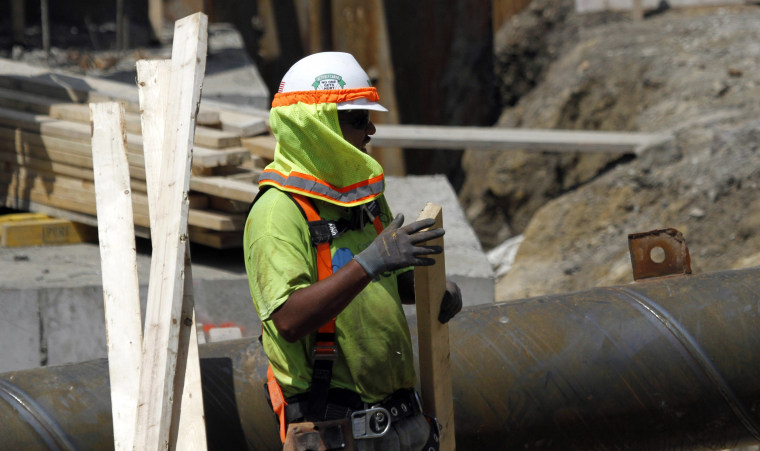A heat alert grew Wednesday to include parts of 21 states as a "heat dome" is expected hover over much of the nation later this week, with some places forecast to reach up to a dangerous 115 degrees.
The sizzling heat index — a measure of how hot it feels when humidity is factored in with the actual air temperature — will first hit parts of the central U.S. during the latter half of the week and will then spread toward the Northeast and mid-Atlantic late this week into the weekend, according to weather.com.
Related: It Just Got So Hot in Baghdad Nobody Has to Work
The intense weather is the result of an atmospheric phenomenon called a heat dome — a ridge, or high-pressure system, that traps hot air underneath it — creating unusually hot and humid conditions.
Heat alerts had been issued for more than a dozen states from Louisiana to Minnesota. Heat advisories were extended to cover parts of Michigan, Indiana and northwest Ohio, and Kentucky, and in larger areas of states already under watch. Excessive heat warnings were in place for all of Iowa and large parts of Nebraska, the Dakotas and Illinois.
Even President Barack Obama on Wednesday took to Twitter to warn Americans about the heat. "Drink water, stay out of the sun, and check on your neighbors," the president said.
In a Chicago suburb on Tuesday, a 4-year-old girl was hospitalized after crawling in a car where she remained for about 15 to 20 minutes before being found, the McHenry County Sheriff’s Office said Wednesday. The temperature in Chicago was in the high 80s Tuesday.
The St. Louis County medical examiner’s office on Tuesday confirmed that the death of a 90-year-old woman last week was due to heat. Her air conditioning was not working, the medical examiner’s office said. The death of another elderly woman in Missouri in June was blamed on the heat, officials said.
The temperature in the South Dakota capital of Pierre reached 105 degrees Wednesday afternoon. Misty Black Bear, who works for the state, watched as her new chocolate ice cream cone immediately started melting in the sun. She said she's fortunate her office has air conditioning.
State workers Katie Hruska and Kelsey Weber ate ice cream in the shade but planned to head right back inside when they were done.
"I eat ice cream in the winter, too, because it's delicious," Hruska said. "But, did we pick ice cream today because it's hot? Yes."
Midwest cities, including Omaha, Nebraska, and Des Moines, Iowa, will experience temperatures near 100 degrees with heat indices well above 100, according to weather.com. And there will be little reprieve once night falls, with temperatures only getting down as low as the 70s.
Jerry Main, who plants corn and soybeans on about 500 acres in southeast Iowa near Fairfield, said farmers plan outdoor work in early mornings to avoid the hottest part of the day.
"As far as cutting weeds by hand or manual labor outside I would say most farmers will spend a good share of the afternoon in the house," he said.
The Southeast won't be spared, either. Weekend highs are forecast to range from the mid-90s to close to 100 degrees; Nashville could see its first 100-degree reading in four years.
And starting Friday, major cities along the eastern seaboard, including Washington, D.C., Philadelphia, and New York City could experience highs in the upper 90s to close to 100 degrees. The nation's capital hasn't had 100-degree weather since July 2012, weather.com said.
In all, about 200 million people will experience temperatures of 90 degrees or higher, and 130 million will experience heat indices of 100 degrees or high, meteorologists said.


